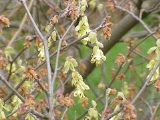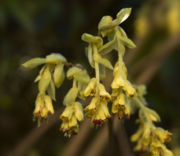
Corylopsis
Encyclopedia
Corylopsis is a genus of nearly 30 species of shrub
s in the witch hazel family, Hamamelidaceae
, native to eastern Asia
with the majority of species endemic in China
but with some also in Japan
, Korea
, and the Himalaya. This genus is also known from the extinct species Corylopsis reedae described from Eocene
leaf fossils found in Washington State, USA.
They grow to 2-6 m tall, and often with a crown wider than tall. The leaves
are ovate with an acute apex and a serrated margin, 4-20 cm long and 3-15 cm broad. The flower
s are produced in late winter in pendulous raceme
s 3-9 cm long with 5-30 flowers; each flower has five pale yellow petals, 4-9 mm long. The fruit
is a dry capsule
10-12 mm long, containing two glossy black seed
s.
Selected species:Native to China unless otherwise indicated
 They are often grown in gardens for their very early, yellow flowers. They do have weak branches though, which are often damaged by heavy snow loads. Corylopsis prefers to grow in semi-shade or shade, protected from strong winds. It grows best on humus-rich soils. The sweetly scented flowering branches keep well in a vase. Corylopsis also makes good bonsai plants, especially C. pauciflora.
They are often grown in gardens for their very early, yellow flowers. They do have weak branches though, which are often damaged by heavy snow loads. Corylopsis prefers to grow in semi-shade or shade, protected from strong winds. It grows best on humus-rich soils. The sweetly scented flowering branches keep well in a vase. Corylopsis also makes good bonsai plants, especially C. pauciflora.
Shrub
A shrub or bush is distinguished from a tree by its multiple stems and shorter height, usually under 5–6 m tall. A large number of plants may become either shrubs or trees, depending on the growing conditions they experience...
s in the witch hazel family, Hamamelidaceae
Hamamelidaceae
The Hamamelidaceae is a family of flowering plants in the order Saxifragales, including 27 genera and about 80-90 species, all shrubs and small trees...
, native to eastern Asia
Asia
Asia is the world's largest and most populous continent, located primarily in the eastern and northern hemispheres. It covers 8.7% of the Earth's total surface area and with approximately 3.879 billion people, it hosts 60% of the world's current human population...
with the majority of species endemic in China
China
Chinese civilization may refer to:* China for more general discussion of the country.* Chinese culture* Greater China, the transnational community of ethnic Chinese.* History of China* Sinosphere, the area historically affected by Chinese culture...
but with some also in Japan
Japan
Japan is an island nation in East Asia. Located in the Pacific Ocean, it lies to the east of the Sea of Japan, China, North Korea, South Korea and Russia, stretching from the Sea of Okhotsk in the north to the East China Sea and Taiwan in the south...
, Korea
Korea
Korea ) is an East Asian geographic region that is currently divided into two separate sovereign states — North Korea and South Korea. Located on the Korean Peninsula, Korea is bordered by the People's Republic of China to the northwest, Russia to the northeast, and is separated from Japan to the...
, and the Himalaya. This genus is also known from the extinct species Corylopsis reedae described from Eocene
Eocene
The Eocene Epoch, lasting from about 56 to 34 million years ago , is a major division of the geologic timescale and the second epoch of the Paleogene Period in the Cenozoic Era. The Eocene spans the time from the end of the Palaeocene Epoch to the beginning of the Oligocene Epoch. The start of the...
leaf fossils found in Washington State, USA.
They grow to 2-6 m tall, and often with a crown wider than tall. The leaves
Leaf
A leaf is an organ of a vascular plant, as defined in botanical terms, and in particular in plant morphology. Foliage is a mass noun that refers to leaves as a feature of plants....
are ovate with an acute apex and a serrated margin, 4-20 cm long and 3-15 cm broad. The flower
Flower
A flower, sometimes known as a bloom or blossom, is the reproductive structure found in flowering plants . The biological function of a flower is to effect reproduction, usually by providing a mechanism for the union of sperm with eggs...
s are produced in late winter in pendulous raceme
Raceme
A raceme is a type of inflorescence that is unbranched and indeterminate and bears pedicellate flowers — flowers having short floral stalks called pedicels — along the axis. In botany, axis means a shoot, in this case one bearing the flowers. In a raceme, the oldest flowers are borne...
s 3-9 cm long with 5-30 flowers; each flower has five pale yellow petals, 4-9 mm long. The fruit
Fruit
In broad terms, a fruit is a structure of a plant that contains its seeds.The term has different meanings dependent on context. In non-technical usage, such as food preparation, fruit normally means the fleshy seed-associated structures of certain plants that are sweet and edible in the raw state,...
is a dry capsule
Capsule (fruit)
In botany a capsule is a type of simple, dry fruit produced by many species of flowering plants. A capsule is a structure composed of two or more carpels that in most cases is dehiscent, i.e. at maturity, it splits apart to release the seeds within. A few capsules are indehiscent, for example...
10-12 mm long, containing two glossy black seed
Seed
A seed is a small embryonic plant enclosed in a covering called the seed coat, usually with some stored food. It is the product of the ripened ovule of gymnosperm and angiosperm plants which occurs after fertilization and some growth within the mother plant...
s.
Selected species:Native to China unless otherwise indicated
|
Corylopsis spicata Corylopsis spicata is a plant in the witch hazel family, Hamamelidaceae. It is a shrub with alternate, simple leaves, on thin, flexible, horizontal stems. The flowers are yellow, borne in late winter and early spring.... (Japan) |
Cultivation and uses


